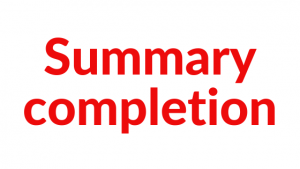Summary Completion Question in Ielts Reading
Summary Completion Question in Ielts Reading
در این قسمت از سوالات آیلتس باید خلاصه ای از متن را که بعد از متن اصلی به صورت یک متن دارای جای خالی می آید کامل کنید. لغات باید از متن اصلی انتخاب شوند.

- Task:
- Completing a summary by filling in the gaps using words from the passage or words given in a box
- Skills:
- scanning for specific information in the passage
- understanding ideas and supporting points
- selecting appropriate words
- Tips:
- identify the type of word needed for each gap (noun/verb/adjective etc)
- locate the information in the passage in order to choose the right word
- if you choose words from the passage, check how many words can be used for each answer
- answers usually come in order
- the summary must be grammatically correct which can help you in choosing the right word for the gap
To answer a summary question in IELTS reading, you should skim read the passage and then spend time reading through the summary to predict answers and prepare paraphrases. This is a practice lesson for summaries.
Summary Completion Question in Ielts Reading
sample:
Fermented Foods
Fermentation is a process in which an agent [typically bacteria and yeast] cause an organic substance to break down into simpler substances; especially, the anaerobic [no oxygen] breakdown of sugar into alcohol, i.e. the making of beer or wine. Fermentation in food processing is the conversion of carbohydrates (plant foods) to alcohols and carbon dioxide, or organic acids, using yeasts, bacteria, or a combination thereof, under anaerobic (no oxygen) conditions. Fermentation usually implies that the action of microorganisms is desirable, and the process is used to produce alcoholic beverages such as wine, beer, and cider. Fermentation is also employed in the leavening of bread, and for preservation techniques to create lactic acid in sour foods such as sauerkraut, dry sausages, kimchi and yogurt, or vinegar (acetic acid) for use in pickling foods.
Nobel Prize winner Dr. Elie Metchnikoff was one of the first scientists to recognize the benefits of eating fermented foods. His research in the early 1900’s focused on the Bulgarians. He believed the daily ingestion of yogurt was a major contribution to their superior health and longevity.
Bulgarians perfected the art of detoxifying and preserving milk (removing the lactose and predigesting the proteins) and transforming it into yogurt and cheese. For centuries, Europeans used wine as a source of clean, durable water. The Caucasians used Kefir grains for the same purpose: detoxify milk products to make Kefir. Vegetables were also fermented to preserve them from spoilage, such as kimchi in Korea. Most of the pickled products found on our grocery shelves were at one time a fermented product: pickles, saurkraut, and even catsup (a Chinese word for pickled fish brine). However, since fermentation isn’t always a uniform process, manufacturers found another way to make these products.
Questions 1-6
Complete the summary using the list of words (A-J) below. Write the correct letter on your answer sheet, in boxes 1-6
International Uses for Fermentation
At the start of the 20th century, Dr. Elie Metchnikoff put forward his belief that the 1. ……………… and good health of Bulgarians could be attributed to eating fermented food each day. By 2. ……………. and preserving milk, they were able to convert it into 3……………… and 4. …………………. In other parts of Europe, fermented 5. ……………… was consumed as a replacement for clean water. Some 6. ……………….. were fermented which gave them a longer lifespan but nowadays this is done by pickling.
A) ingesting B) yoghurt C ) longevity D) pickled products E) wine F) food G) kimchi H) cheese I) detoxifying J) vegetables
Answer:
- C
- I
- B (any order)
- H (any order)
- E
- J
Summary Completion Question in Ielts Reading
بر روی درس های زیر کلیک کنید.
انواع دیگر سوالات ریدینگ آیلتس
| Matching Headings Questions | Ielts reading LESSON 1 |
| True False Not Given | Ielts reading LESSON 2 |
| Matching Paragraph Information | Ielts reading LESSON 3 |
| Summary Completion Question | Ielts reading LESSON 4 |
| Sentence Completion Questions | Ielts reading LESSON 5 |
| Multiple Choice Questions | Ielts reading LESSON 6 |
| Choosing a Title in Ielts Reading | Ielts reading LESSON 7 |
| Matching Sentence Endings | Ielts reading LESSON 8 |
| Table Completion | Ielts reading LESSON 9 |
| Short Answer Questions | Ielts reading LESSON 10 |
|
مطالب مرتبط |
| ثبت نام کلاس آنلاین زبان انگلیسی |





سلام استاد تشکر میکنم از پکیج های خوبتون
سلام استاد، پکیج ها و کلاس ها عالی. تشکر